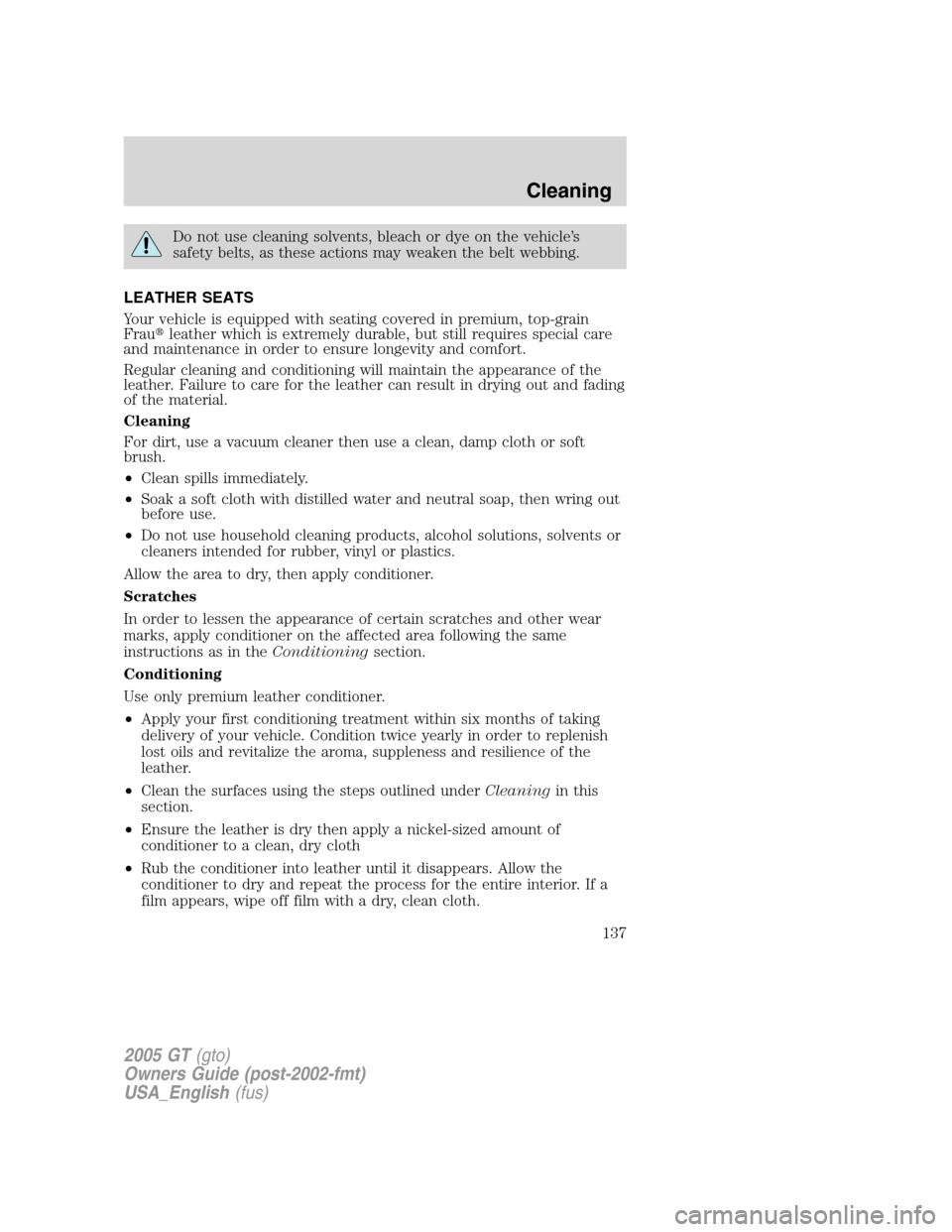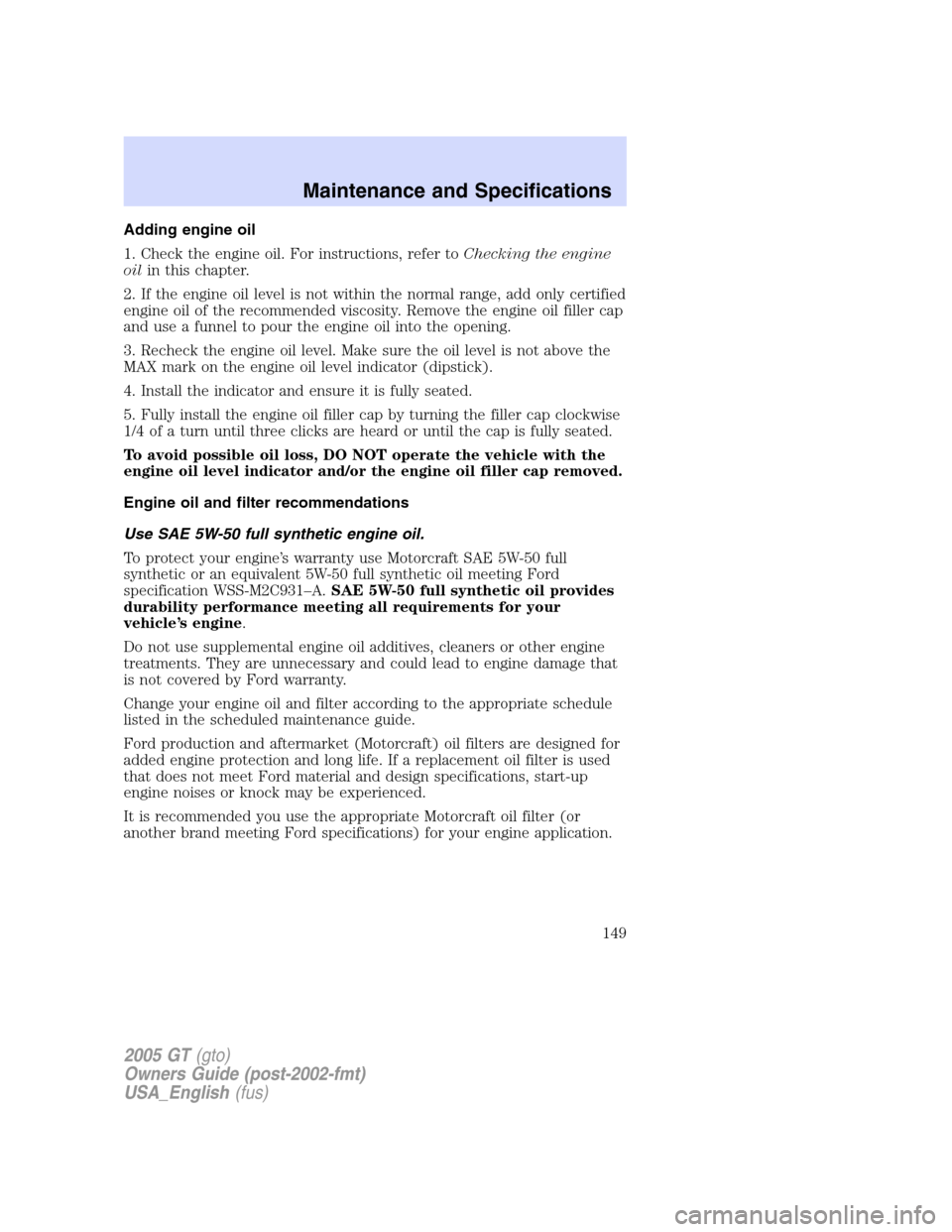Page 137 of 200

Do not use cleaning solvents, bleach or dye on the vehicle’s
safety belts, as these actions may weaken the belt webbing.
LEATHER SEATS
Your vehicle is equipped with seating covered in premium, top-grain
Frau �leather which is extremely durable, but still requires special care
and maintenance in order to ensure longevity and comfort.
Regular cleaning and conditioning will maintain the appearance of the
leather. Failure to care for the leather can result in drying out and fading
of the material.
Cleaning
For dirt, use a vacuum cleaner then use a clean, damp cloth or soft
brush.
• Clean spills immediately.
• Soak a soft cloth with distilled water and neutral soap, then wring out
before use.
• Do not use household cleaning products, alcohol solutions, solvents or
cleaners intended for rubber, vinyl or plastics.
Allow the area to dry, then apply conditioner.
Scratches
In order to lessen the appearance of certain scratches and other wear
marks, apply conditioner on the affected area following the same
instructions as in the Conditioningsection.
Conditioning
Use only premium leather conditioner.
• Apply your first conditioning treatment within six months of taking
delivery of your vehicle. Condition twice yearly in order to replenish
lost oils and revitalize the aroma, suppleness and resilience of the
leather.
• Clean the surfaces using the steps outlined under Cleaningin this
section.
• Ensure the leather is dry then apply a nickel-sized amount of
conditioner to a clean, dry cloth
• Rub the conditioner into leather until it disappears. Allow the
conditioner to dry and repeat the process for the entire interior. If a
film appears, wipe off film with a dry, clean cloth.
2005 GT(gto)
Owners Guide (post-2002-fmt)
USA_English (fus)
Cleaning
137
Page 144 of 200
IDENTIFYING COMPONENTS IN THE ENGINE COMPARTMENT
5.4L 4V DOHC Supercharged V8 engine
1. Power steering fluid reservoir
2. Engine oil dipstick
3. Engine oil filler cap
2005 GT(gto)
Owners Guide (post-2002-fmt)
USA_English(fus)
Maintenance and Specifications
144
Page 145 of 200
4. Engine oil filter
5. Engine coolant reservoir
6. Intercooler coolant reservoir
7. Engine air filter
2005 GT(gto)
Owners Guide (post-2002-fmt)
USA_English(fus)
Maintenance and Specifications
145
Page 147 of 200

WINDSHIELD WASHER FLUID
Add fluid to fill the reservoir if the
level is low. Standard fill amount is 1
quart (0.9 L).
Only use a washer fluid that meets
Ford specification WSB-M8B16–A2.
Refer to Lubricant specifications
in this chapter.
State or local regulations on volatile organic compounds may restrict the
use of methanol, a common windshield washer antifreeze additive.
Washer fluids containing non-methanol antifreeze agents should be used
only if they provide cold weather protection without damaging the
vehicle ’s paint finish, wiper blades or washer system.
If you operate your vehicle in temperatures below 40 °F (4.5 °C),
use washer fluid with antifreeze protection. Failure to use
washer fluid with antifreeze protection in cold weather could result in
impaired windshield vision and increase the risk of injury or accident.
Note: Do not put washer fluid in the engine coolant reservoir. Washer
fluid placed in the cooling system may harm engine and cooling system
components.
ENGINE OIL
Checking the engine oil
Refer to the scheduled maintenance guide for the appropriate intervals
for checking the engine oil.
1. Make sure the vehicle is on level ground.
2. Turn the engine off.
3. Set the parking brake and ensure the gearshift is securely latched in 1
(First).
2005 GT(gto)
Owners Guide (post-2002-fmt)
USA_English (fus)
Maintenance and Specifications
147
Page 148 of 200
4. Open the engine compartment cover. Protect yourself from engine
heat.
5. Locate and carefully remove the engine oil level indicator (dipstick).
6. Wipe the indicator clean. Insert
the indicator fully, then remove it
again.
Check oil level within 1 minute of
shutting off the vehicle.
•If the oil level is between the MIN—MAX marks, the oil level is
acceptable. DO NOT ADD OIL.
• If the oil level is below the MIN mark, add enough oil to raise the level
within the MIN—MAX range.
• Oil levels above the MAX mark
may cause engine damage. Some
oil must be removed from the
engine by a service technician.
7. Put the indicator back in and ensure it is fully seated.
2005 GT(gto)
Owners Guide (post-2002-fmt)
USA_English (fus)
Maintenance and Specifications
148
Page 149 of 200

Adding engine oil
1. Check the engine oil. For instructions, refer toChecking the engine
oil in this chapter.
2. If the engine oil level is not within the normal range, add only certified
engine oil of the recommended viscosity. Remove the engine oil filler cap
and use a funnel to pour the engine oil into the opening.
3. Recheck the engine oil level. Make sure the oil level is not above the
MAX mark on the engine oil level indicator (dipstick).
4. Install the indicator and ensure it is fully seated.
5. Fully install the engine oil filler cap by turning the filler cap clockwise
1/4 of a turn until three clicks are heard or until the cap is fully seated.
To avoid possible oil loss, DO NOT operate the vehicle with the
engine oil level indicator and/or the engine oil filler cap removed.
Engine oil and filter recommendations
Use SAE 5W-50 full synthetic engine oil.
To protect your engine ’s warranty use Motorcraft SAE 5W-50 full
synthetic or an equivalent 5W-50 full synthetic oil meeting Ford
specification WSS-M2C931 –A. SAE 5W-50 full synthetic oil provides
durability performance meeting all requirements for your
vehicle ’s engine .
Do not use supplemental engine oil additives, cleaners or other engine
treatments. They are unnecessary and could lead to engine damage that
is not covered by Ford warranty.
Change your engine oil and filter according to the appropriate schedule
listed in the scheduled maintenance guide.
Ford production and aftermarket (Motorcraft) oil filters are designed for
added engine protection and long life. If a replacement oil filter is used
that does not meet Ford material and design specifications, start-up
engine noises or knock may be experienced.
It is recommended you use the appropriate Motorcraft oil filter (or
another brand meeting Ford specifications) for your engine application.
2005 GT(gto)
Owners Guide (post-2002-fmt)
USA_English (fus)
Maintenance and Specifications
149
Page 152 of 200

ENGINE COOLANT
Checking engine/intercooler coolant
The concentration and level of engine/intercooler coolant should be
checked at the mileage intervals listed in theScheduled Maintenance
Guide . The coolant concentration should be maintained at 50/50 coolant
and distilled water, which equates to a freeze point of -34°F (-36°C).
Coolant concentration testing is possible with a hydrometer or antifreeze
tester (such as the Rotunda Battery and Antifreeze Tester, 014–R1060).
The level of coolant should be maintained at the bottom of the lower
baffle in the coolant reservoir. If the level falls below, add coolant per the
instructions in the Adding engine coolant section.
Your vehicle was factory-filled with a 50/50 engine coolant and water
concentration. If the concentration of coolant falls below 40% or above
60%, the engine parts could become damaged or not work properly. A
50–50 mixture of coolant and water provides the following:
• Freeze protection down to -34°F (-36°C).
• Boiling protection up to 265°F (129°C).
• Protection against rust and other forms of corrosion.
• Enables calibrated gauges to work properly.
1. Engine coolant reservoir
2. Intercooler coolant reservoir
2005 GT(gto)
Owners Guide (post-2002-fmt)
USA_English (fus)
Maintenance and Specifications
152
Page 162 of 200

Keep a record for at least one month and record the type of driving (city
or highway). This will provide an accurate estimate of the vehicle’s fuel
economy under current driving conditions. Additionally, keeping records
during summer and winter will show how temperature impacts fuel
economy. In general, lower temperatures give lower fuel economy.
Driving style —good driving and fuel economy habits
Give consideration to the lists that follow and you may be able to change
a number of variables and improve your fuel economy.
Habits
• Smooth, moderate operation can yield up to 10% savings in fuel.
• Steady speeds without stopping will usually give the best fuel
economy.
• Idling for long periods of time (greater than one minute) may waste
fuel.
• Anticipate stopping; slowing down may eliminate the need to stop.
• Sudden or hard accelerations may reduce fuel economy.
• Slow down gradually.
• Driving at reasonable speeds (traveling at 55 mph [88 km/h] uses 15%
less fuel than traveling at 65 mph [105 km/h]).
• Revving the engine before turning it off may reduce fuel economy.
• Using the air conditioner or defroster may reduce fuel economy.
• Resting your foot on the brake pedal while driving may reduce fuel
economy.
• Combine errands and minimize stop-and-go driving.
Maintenance
• Keep tires properly inflated and use only recommended size.
• Operating a vehicle with the wheels out of alignment will reduce fuel
economy.
• Use recommended engine oil. Refer to Lubricant specificationsin
this chapter.
• Perform all regularly scheduled maintenance items. Follow the
recommended maintenance schedule and owner maintenance checks
found in the scheduled maintenance guide chapter.
2005 GT(gto)
Owners Guide (post-2002-fmt)
USA_English (fus)
Maintenance and Specifications
162